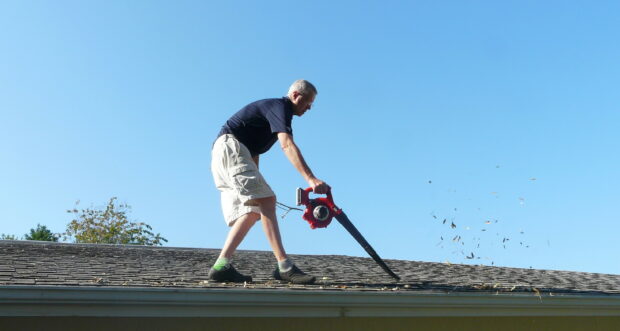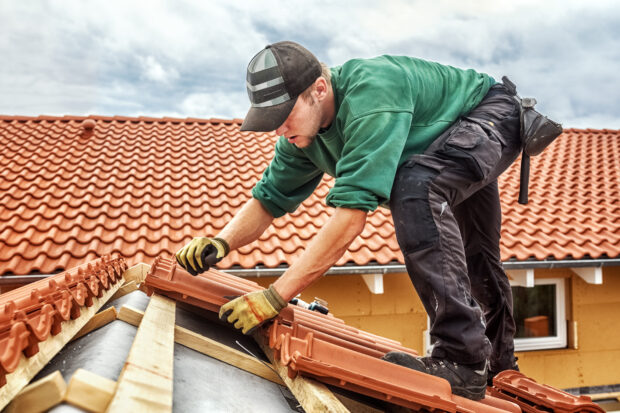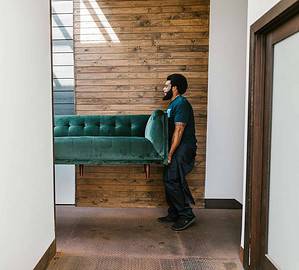There are many types of roof problems. As a homeowner, you need to determine what factors are causing such problems. For all you know, you only need to clean and take away the debris stuck in your gutter and your roof is already back to its tiptop condition. However, some issues are not as easy to tackle as the minor ones. If you want to cut on labor costs and do some DIY magic trick to fix your roof, then read on! We’ll help you work on your roof repair project by giving you some DIY tips.

Common Types of Roof Problems
As mentioned, not all roof problems are the same. In most cases, you can remedy the problems yourself, but there are times when you really need to consider replacing your roof. So, before you embark on a DIY roof repair, you must first determine the problems hounding your roof. Here are the common roof troubles that may cause you headaches:
- Leaky Roof
- Blisters On The Roof
- Moss Growth
- Damaged Gutter
4 Easy DIY Fixes For Your Roof
Now that you know the most common roof problems, if you feel that you can do the job, you can start fixing your roof. Don’t worry, simple DIY repairs don’t require heavy equipment. Also, all the materials that you need are easily available in hardware stores.
1.Replace Shingles Or Reseal Damaged Flashing
Leaks are the biggest roof problems. They start out small and over time they can compromise a big part of your roofing structure. You can easily determine if your roof has leaks if you see ceiling stains or smell molds in the problematic area. You need to deal with leaks right away so you don’t have to face expensive repairs. Of course, you can patch up minor leaks yourself. But if you think things have gotten out of hand, then it’s time to call the help of roofing professionals like Roof Repair Rome GA.
Leaks can be caused by one or a few damaged shingles. To fix this, pry off the damaged shingle from the overlaps. You may need to pull out the nails that fasten it to the battens. Once the damaged shingle has been taken out, make sure to remove roof mortar particles and other debris stuck in the affected area.
Prepare the new shingle. Make sure it matches the size of the other shingles. To make it easy for you to slide it in place, round the back corners of the new shingle using a utility knife. Make sure it properly lines up with the overlapping shingles above and below it. Use roofing nails to fasten the new shingle to the batten. Apply caulk or putty to cover the nails for added protection.
Leaks can also be caused by damaged roof flashing. This is made of thin material used to lead water away from critical structures of the roof. Flashings can be found around chimneys and dormers. To repair damaged flashing, you can start off by resealing them with roofing cement. Replacing roof flashing should be left in the hands of professionals to prevent costly damages.
2.Make An Incision On The Affected Area
Blisters or bubbles are caused by moisture being trapped in the shingles, which in turn may be brought about by excessive heat and poor roofing ventilation or poor roof installation.
To repair roof impregnations, simply make an incision on the affected area and lift it open. But remember not to totally cut off the material. Apply a liberal amount of roofing cement and then reattach the roofing material. Add a fresh row of roofing nails on the area where you made the incision for added protection. Also, cover the nails with more cement.
3.Don’t Tolerate Moss Growth
For some folks, mosses are nice to look at as they lend a deep green color to surfaces. Also, a mossy roof can be a huge hit for homeowners who want an environment-friendly structure. But make no mistake, moss growth on your roof can clog your gutters and eventually cause your roof to degrade. Get rid of the moss growing on your roof as soon as you see them in order to prevent this from happening.
Spray the affected areas with a solution of 50% bleach and 50% water. Leave for about half an hour and then rinse with water.
4.Check Your Gutters
It’s easy for most people to think of their roofs as only made up of shingles, beams, and rafters. But technically, gutters are also part of the roof. Clogged or damaged gutters can cause problems not just to your roof but to the overall structure of your home.
Always make sure that water can freely flow down from the gutter. If your gutters are damaged, quickly replace them. If left unchecked, water could overflow and cause rotting on the sides of your home or even ruin your landscaping.
Conclusion
A do-it-yourself approach to fixing your roof problems can be an adventure on its own. Plus, you can also avoid huge costs since you don’t have to pay labor expenses. Still, most DIY solutions are temporary. There may come a time that you will need to call in professional roofers. You may even need them to replace your roofing system entirely.




